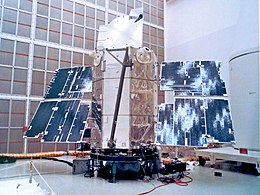Orbiting Astronomical Observatory 2
The Orbiting Astronomical Observatory 2 (OAO-2, nicknamed Stargazer) was the first successful space telescope (first space telescope being OAO-1, which failed to operate once in orbit), launched on December 7, 1968.
An Atlas-Centaur rocket launched it into a nearly circular 750-kilometre (470 mi) altitude Earth orbit. Data was collected in ultraviolet on many sources including comets, planets, and galaxies. It had two major instrument sets facing in opposite directions; the Smithsonian Astrophysical Observatory (SAO) and the Wisconsin Experiment Package (WEP). One discovery was large halos of hydrogen gas around comets, and it also observed Nova Serpentis, which was a nova discovered in 1970.
 Technicians in a clean room at NASA’s Kennedy Space Center in Cape Canaveral, Florida, check out the Orbiting Astronomical Observatory 2 before the mission’s Dec. 7, 1968, launch. | |
| Mission type | Astronomy |
|---|---|
| Operator | NASA |
| COSPAR ID | 1968-110A |
| SATCAT no. | 3597 |
| Spacecraft properties | |
| Manufacturer | Grumman |
| Dry mass | 2,012 kilograms (4,436 lb) |
| Start of mission | |
| Launch date | 7 December 1968, 08:40:09 UTC |
| Rocket | Atlas SLV-3C Centaur-D |
| Launch site | Cape Canaveral LC-36B |
| End of mission | |
| Disposal | Telescope issues |
| Deactivated | February 1973 |
| Orbital parameters | |
| Reference system | Geocentric |
| Regime | Low Earth |
| Perigee altitude | 768 kilometres (477 mi) |
| Apogee altitude | 777 kilometres (483 mi) |
| Inclination | 35.0 degrees |
| Period | 100.30 minutes |
| Epoch | 6 January 1969 |
Celescope: Smithsonian Astrophysical Observatory
The Smithsonian Astrophysical Observatory, also called Celescope, had four 12 inch (30.5 cm) Schwarzschild telescopes that fed into Uvicons. The Uvicon was an ultra-violet light detector based on the Westinghouse Vidicon. Ultraviolet light was converted into electrons which were in turn converted to a voltage as those electrons hit the detection area of the tube. There has been a Uvicon in the collection of the Smithsonian Institution since 1973.
Various filters, photocathodes, and electronics aided in collecting data in several ultraviolet light passbands. The detectors showed a gradual loss of sensitivity and the experiment was turned off in April 1970. By the time it finished about 10 percent of the sky was observed resulting in a catalog of 5,068 UV stars.
Wisconsin Experiment Package
The Wisconsin Experiment Package had seven different telescopes for ultraviolet observations. For example, there was a nebular photoelectric photometer fed by a 16-inch (40.64 cm) telescope with a six-position filter wheel that unfortunately failed a few weeks after launch.
Construction was supervised by Arthur Code of the University of Wisconsin-Madison. WEP observed over 1200 targets in ultraviolet light before the mission ended in early 1973.
Discoveries
In addition to the Celescope's catalog of UV stars, the WEP observed comet Tago-Sato-Kosaka and found it to be surrounded by a cloud of hydrogen, confirming that the comet was largely made up of water, and detected the 2175-angstrom bump, an increase in UV absorption at that wavelength that is still not fully explained.
Spacecraft bus
The observatory was built in the shape of an octagonal prism. It measured about 10 by 7 ft (3.0 by 2.1 m) and weighed 4,400 lb (2,000 kg).
See also
References
External links
- OAO 2 observations of the Alpha Persei cluster
- OAO-2 Info and pics
- 50th Anniversary Overview of OAO-2 including video
This article uses material from the Wikipedia English article Orbiting Astronomical Observatory 2, which is released under the Creative Commons Attribution-ShareAlike 3.0 license ("CC BY-SA 3.0"); additional terms may apply (view authors). Content is available under CC BY-SA 4.0 unless otherwise noted. Images, videos and audio are available under their respective licenses.
®Wikipedia is a registered trademark of the Wiki Foundation, Inc. Wiki English (DUHOCTRUNGQUOC.VN) is an independent company and has no affiliation with Wiki Foundation.